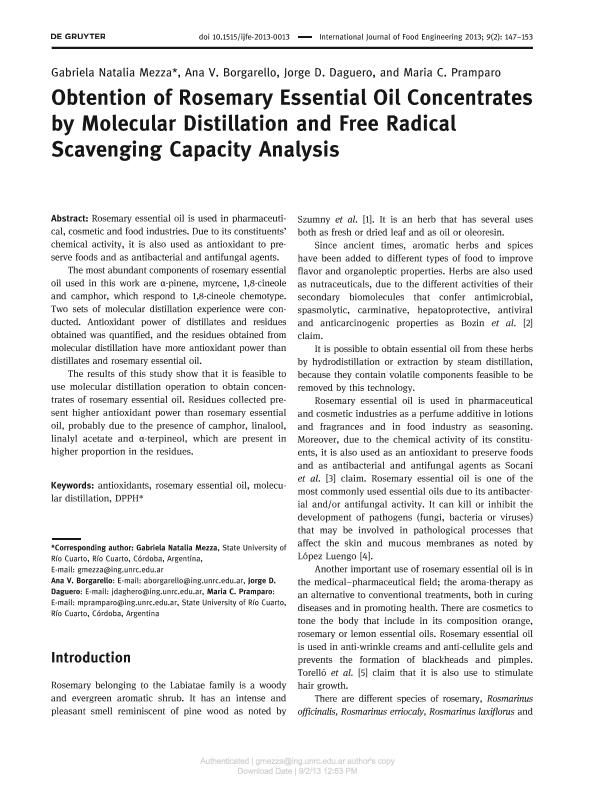Artículo
Obtention of Rosemary Essential Oil Concentrates by Molecular Distillation and Free Radical Scavenging Capacity Analysis
Fecha de publicación:
06/2013
Editorial:
De Gruyter
Revista:
International Journal Of Food Engineering
ISSN:
1556-3758
Idioma:
Inglés
Tipo de recurso:
Artículo publicado
Clasificación temática:
Resumen
Rosemary essential oil is used in pharmaceutical, cosmetic and food industries. Due to its constituents’ chemical activity, it is also used as antioxidant to preserve foods and as antibacterial and antifungal agents. The most abundant components of rosemary essential oil used in this work are α-pinene, myrcene, 1,8-cineole and camphor, which respond to 1,8-cineole chemotype. Two sets of molecular distillation experience were conducted. Antioxidant power of distillates and residues obtained was quantified, and the residues obtained from molecular distillation have more antioxidant power than distillates and rosemary essential oil. The results of this study show that it is feasible to use molecular distillation operation to obtain concentrates of rosemary essential oil. Residues collected present higher antioxidant power than rosemary essential oil, probably due to the presence of camphor, linalool, linalyl acetate and α-terpineol, which are present in higher proportion in the residues.
Palabras clave:
Antioxidants
,
Rosemary Essential Oil
,
Molecular Distillation
,
Dpph
Archivos asociados
Licencia
Identificadores
Colecciones
Articulos(CCT - CORDOBA)
Articulos de CTRO.CIENTIFICO TECNOL.CONICET - CORDOBA
Articulos de CTRO.CIENTIFICO TECNOL.CONICET - CORDOBA
Citación
Mezza, Gabriela Natalia; Borgarello, Ana Valeria; Daguero, Jorge D.; Pramparo, Maria del Carmen; Obtention of Rosemary Essential Oil Concentrates by Molecular Distillation and Free Radical Scavenging Capacity Analysis; De Gruyter; International Journal Of Food Engineering; 9; 2; 6-2013; 1-7
Compartir
Altmétricas




